Process For Preparing Sphingolipids
Eckstein; Marrit Friederike ; et al.
U.S. patent application number 16/355981 was filed with the patent office on 2019-10-03 for process for preparing sphingolipids. This patent application is currently assigned to Evonik Degussa GmbH. The applicant listed for this patent is Evonik Degussa GmbH. Invention is credited to Marrit Friederike Eckstein, Claudia Hierath, Sunay Karacocuk, Ursula Maczkiewitz, Annika Schrader, Andreas Seifert, Monica Desiree van Logchem, Hans Henning Wenk.
| Application Number | 20190300917 16/355981 |
| Document ID | / |
| Family ID | 61837624 |
| Filed Date | 2019-10-03 |


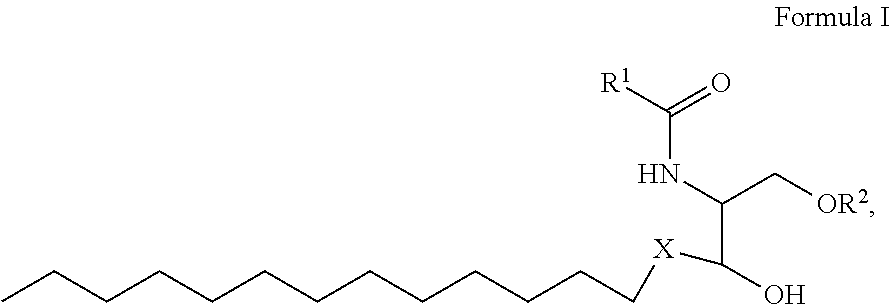

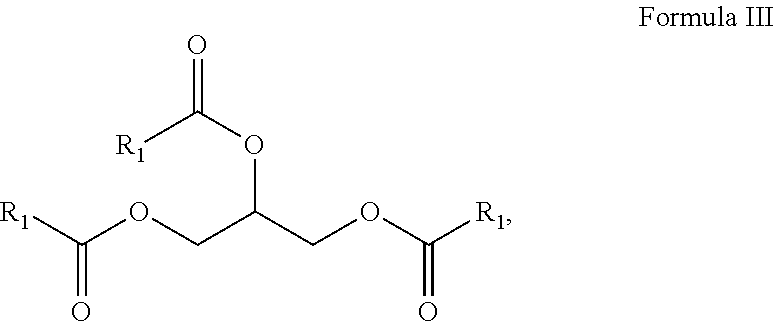

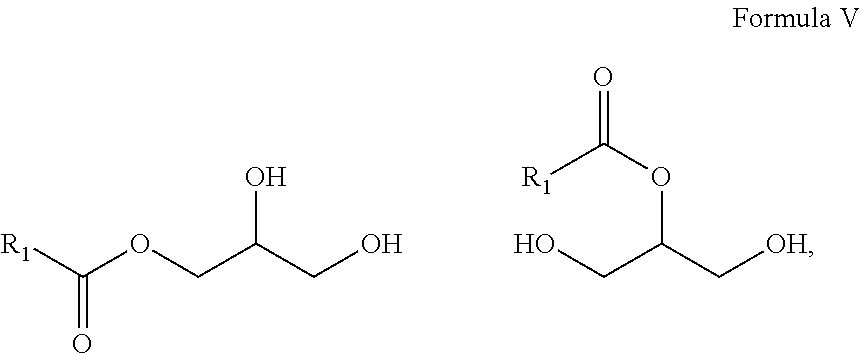
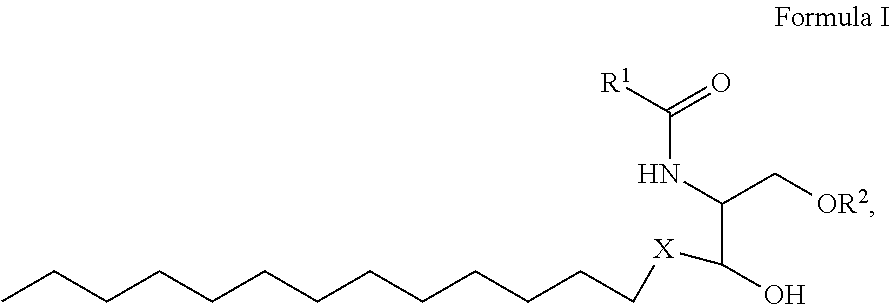


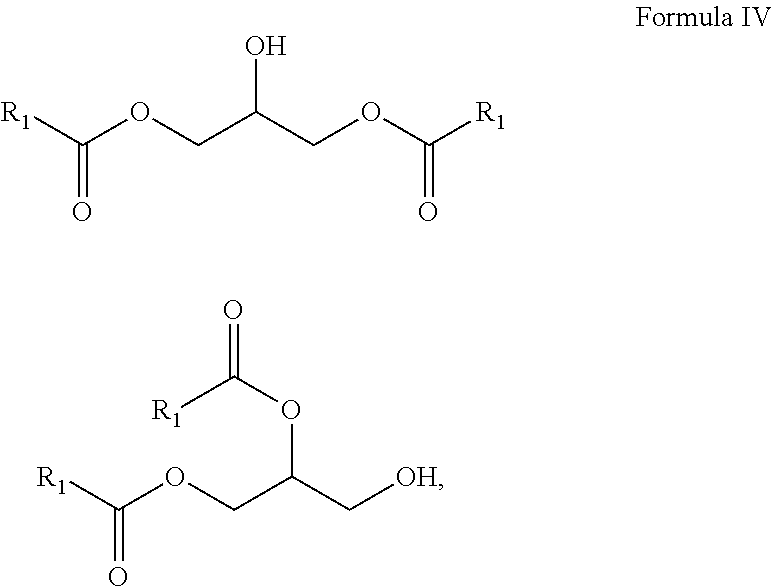
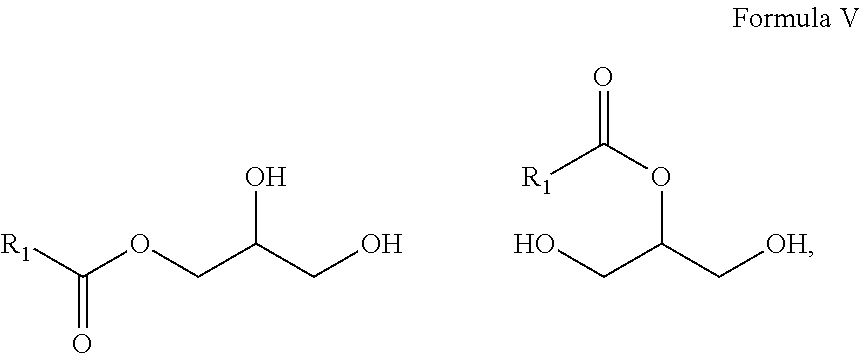
View All Diagrams
| United States Patent Application | 20190300917 |
| Kind Code | A1 |
| Eckstein; Marrit Friederike ; et al. | October 3, 2019 |
PROCESS FOR PREPARING SPHINGOLIPIDS
Abstract
The invention provides a process for preparing sphingolipids, compositions comprising sphingolipids and further components, and for the use of the compositions.
| Inventors: | Eckstein; Marrit Friederike; (Essen, DE) ; van Logchem; Monica Desiree; (Zevenbergen, NL) ; Wenk; Hans Henning; (Mulheim an der Ruhr, DE) ; Schrader; Annika; (Bremen, DE) ; Maczkiewitz; Ursula; (Essen, DE) ; Hierath; Claudia; (Essen, DE) ; Karacocuk; Sunay; (Herne, DE) ; Seifert; Andreas; (Bottrop, DE) | ||||||||||
| Applicant: |
|
||||||||||
|---|---|---|---|---|---|---|---|---|---|---|---|
| Assignee: | Evonik Degussa GmbH Essen DE |
||||||||||
| Family ID: | 61837624 | ||||||||||
| Appl. No.: | 16/355981 | ||||||||||
| Filed: | March 18, 2019 |
| Current U.S. Class: | 1/1 |
| Current CPC Class: | A61K 2800/31 20130101; A61Q 19/00 20130101; C12P 13/02 20130101; A61Q 5/12 20130101; C12Y 301/01003 20130101; A61Q 19/007 20130101; A61K 8/92 20130101; A61Q 5/002 20130101; A61K 8/68 20130101; C07H 15/00 20130101; A61Q 5/02 20130101 |
| International Class: | C12P 13/02 20060101 C12P013/02; A61K 8/68 20060101 A61K008/68; A61K 8/92 20060101 A61K008/92 |
Foreign Application Data
| Date | Code | Application Number |
|---|---|---|
| Mar 29, 2018 | EP | 18164835.3 |
Claims
1. A process for preparing sphingolipids of the general formula I ##STR00013## by reacting a first component, a lysosphingolipid of the general formula II ##STR00014## with a second component, an acyl group donor of the acyl group R.sup.1CO, wherein R.sup.1 represents a linear or branched alkyl chain having 2 to 55 carbon atoms that optionally contains one or more multiple bonds and/or aromatic or heteroaromatic rings, is optionally interrupted by oxygen atoms or ester or amide functionalities and is optionally substituted by at least one further group selected from alkyl, hydroxyl, keto or amine groups, R.sup.2 represents H, phosphocholine, serine, ethanolamine or a sugar, and X represents CH.dbd.CH, CH.sub.2--CH.sub.2 or CH.sub.2--HCOH, wherein the first and second components, based on the overall reaction mixture, account for a total of at least 70% by weight, and not more than 600 propyl laurate units of at least one carboxylic ester hydrolase from the E.C. 3.1.1 enzyme class per gram of first component are used in the entire reaction mixture, where one propyl laurate unit is defined as the amount of enzyme that synthesizes one .mu.mol of propyl laurate per minute from 1-propanol and lauric acid.
2. The process according to claim 1, wherein R.sup.2.dbd.H and X.dbd.CH.sub.2--CH.sub.2.
3. The process according to claim 1, wherein the second component is selected from acyl group donors that provide an acyl group selected from the group of acyl groups of natural fatty acids.
4. The process according to claim 1, wherein the second component is selected from esters based on alkanols and polyols having up to 6 carbon atoms.
5. The process according to claim 1, wherein the first component used is sphinganine with R.sup.2.dbd.H and X.dbd.CH.sub.2--CH.sub.2, and the second component used is an acyl group donor selected from the group consisting of coconut fat, palm kernel oil, olive oil, palm oil, argan oil, castor oil, linseed oil and babassu oil.
6. The process according to claim 1, wherein the reactants are present on commencement of the reaction in a molar ratio of first component to second component of 1:0.11 to 1:2000.
7. The process according to claim 1, wherein, based on the overall reaction mixture, the maximum total amount of any solvent present is less than 20% by weight.
8. The process according to claim 1, wherein it is conducted under anhydrous conditions.
9. The process according to claim 1, wherein the carboxylic ester hydrolase is selected from the group of the lipase from Thermomyces lanuginosus with accession number O59952, lipases A and B with accession number P41365 from Candida antarctica and the lipase from Mucor miehei with accession number P19515, the lipase from Humicola sp. with accession number O59952, the lipase from Rhizomucor javanicus with accession number S32492, the lipase from Rhizopus oryzae with accession number P61872, the lipases from Candida rugosa with accession number P20261, P32946, P32947, P3294 and P32949, the lipase from Rhizopus niveus accession number P61871, the lipase from Penicillium camemberti with accession number P25234, the lipases from Aspergillus niger with accession number ABG73613, ABG73614 and ABG37906 and the lipase from Penicillium cyclopium with accession number P61869, and their respective at least 60% homologues at the amino acid level.
10. A composition comprising A) at least one sphingolipid of the general formula I ##STR00015## B) at least one lysosphingolipid of the general formula II ##STR00016## C) at least one triglyceride of the general formula III ##STR00017## D) at least one diglyceride of the general formula IV ##STR00018## E) at least one monoglyceride of the general formula V ##STR00019## where R.sup.1 is the same or different and independently represents a linear or branched alkyl chain having 2 to 55 carbon atoms that optionally contains one or more multiple bonds and/or aromatic or heteroaromatic rings, is optionally interrupted by oxygen atoms or ester or amide functionalities and is optionally substituted by at least one further group selected from alkyl, hydroxyl, keto or amine groups, R.sup.2 is the same or different and independently represents H, phosphocholine, serine, ethanolamine or a sugar, and X represents CH.dbd.CH, CH.sub.2--CH.sub.2 or CH.sub.2--HCOH, wherein based on the total composition, the components are present as follows: A) 30% by weight to 98% by weight, B) 0.01% by weight to 60% by weight, C) 0.01% by weight to 60% by weight, D) 0.1% by weight to 30% by weight, E) 0.1% by weight to 30% by weight.
11. A composition having a high oil content and comprising A) at least one sphingolipid of the general formula I ##STR00020## B) at least one lysosphingolipid of the general formula II ##STR00021## C) at least one triglyceride of the general formula III ##STR00022## D) at least one diglyceride of the general formula IV ##STR00023## E) at least one monoglyceride of the general formula V ##STR00024## where R.sup.1 is the same or different and independently represents a linear or branched alkyl chain having 2 to 55 carbon atoms that optionally contains one or more multiple bonds and/or aromatic or heteroaromatic rings, is optionally interrupted by oxygen atoms or ester or amide functionalities and is optionally substituted by at least one further group selected from alkyl, hydroxyl, keto or amine groups, R.sup.2 is the same or different and independently represents H, phosphocholine, serine, ethanolamine or a sugar, and X represents CH.dbd.CH, CH.sub.2--CH.sub.2 or CH.sub.2--HCOH, wherein the components are present in the composition as follows: A) 30 parts by weight to 98 parts by weight, B) 0.01 part by weight to 60 parts by weight, D) 0.1 part by weight to 30 parts by weight, E) 0.1 part by weight to 30 parts by weight, and, based on the overall composition, C) 60% by weight to 98% by weight.
12. The composition according to claim 10, wherein R.sup.2.dbd.H and X.dbd.CH.sub.2--CH.sub.2 and R.sup.1 is selected from the group consisting of cocyol radicals, palmitoyl radicals, oleyl radicals, linoleyl radicals, linolenyl radicals, ricinoyl radicals, stearyl radicals, erucyl radicals and polyunsaturated fatty acyl radicals.
13. A cosmetic formulation comprising the composition according to claim 10.
14. A retaining skin moisture formulation, for avoiding skin dryness and/or for fortifying the skin barrier retaining, the skin moisture formulation comprising the composition according to claim 10.
15. A hair structure formulation, for repair of the hair structure after UV stress, for boosting the CMC complex in the hair and/or for protecting the hair, especially from protein degradation, the hair structure formulation comprising the according to claim 10.
16. The composition according to claim 10, wherein R.sup.2 is selected from the group consisting of sugar and H, and X is CH.sub.2--CH.sub.2 wherein based on the total composition, the components are present as follows: A) 50% by weight to 90% by weight, B) 0.01% by weight to 45% by weight, C) 0.01% by weight to 45% by weight, D) 0.1% by weight to 20% by weight, E) 0.1% by weight to 20% by weight.
17. The composition according to claim 10, wherein R.sup.2 is H, and X is CH.sub.2--CH.sub.2 wherein based on the total composition, the components are present as follows: A) 65% by weight to 85% by weight, B) 0.5% by weight to 10% by weight, C) 0.01% by weight to 10% by weight, D) 2% by weight to 15% by weight, and E) 2% by weight to 15% by weight.
18. The process according to claim 1, wherein the first and second components, based on the overall reaction mixture, account for a total of at least 95% by weight.
19. The process according to claim 1, wherein, based on the overall reaction mixture, the maximum total amount of any solvent present is less than 5% by weight.
20. The process according to claim 1, wherein the carboxylic ester hydrolase is selected from the group of the lipase from Thermomyces lanuginosus with accession number O59952, lipases A and B with accession number P41365 from Candida antarctica and the lipase from Mucor miehei with accession number P19515, the lipase from Humicola sp. with accession number O59952, the lipase from Rhizomucor javanicus with accession number 532492, the lipase from Rhizopus oryzae with accession number P61872, the lipases from Candida rugosa with accession number P20261, P32946, P32947, P3294 and P32949, the lipase from Rhizopus niveus accession number P61871, the lipase from Penicillium camemberti with accession number P25234, the lipases from Aspergillus niger with accession number ABG73613, ABG73614 and ABG37906 and the lipase from Penicillium cyclopium with accession number P61869, and their respective at least 95% homologues at the amino acid level.
Description
CROSS REFERENCE TO RELATED APPLICATIONS
[0001] This application is a 35 U.S.C. .sctn. 119 patent application which claims the benefit of European Application No. 18164835.3 filed Mar. 29, 2018, which is incorporated herein by reference in its entirety.
FIELD
[0002] The invention provides a process for preparing sphingolipids, compositions comprising sphingolipids and further components, and for the use of the compositions.
BACKGROUND
[0003] US20110077302 discloses a process for biocatalytic preparation of sphingolipids by reacting a lysosphingolipid with carboxylic esters, characterized in that a biocatalyst comprising at least one carboxylic ester hydrolase from the E.C. 3.1.1 enzyme class from an organism from the fungal realm and homologues thereof is used.
[0004] US20110065801 discloses a process for biocatalytic preparation of sphingolipids by reacting a lysosphingolipid with glycerides, wherein a biocatalyst comprising at least one carboxylic ester hydrolase from the E.C. 3.1.1 enzyme class is used.
[0005] The use of high amounts of solvents and high enzyme concentrations are emphasized as being advantageous in the prior art.
SUMMARY
[0006] The problem addressed by the present invention was that of providing an alternative, gentle and industrially applicable route to ceramides in which it is possible to work in a resource-conserving manner.
DETAILED DESCRIPTION
[0007] It has been found that, surprisingly, the process described hereinafter constitutes an excellent alternative to the prior art and surprisingly provides compositions that have advantageous properties.
[0008] The present invention therefore provides a process for preparing sphingolipids as described in claim 1.
[0009] The invention further provides compositions comprising sphingolipids and further components, and for the use thereof.
[0010] One advantage of the process according to the invention is that, by virtue of the very small amounts of solvent and of enzyme used, it is possible to work in a particularly resource-conserving manner. In addition, it has been found that, surprisingly, in the solvent-free conversion, a very small amount of enzyme leads to the best results.
[0011] The use of triglycerides under the reaction conditions according to the invention additionally leads to product mixtures that differ from the prior art, for example US20110065801, by the presence of mono- and diglycerides and additionally have special effects, especially in cosmetic applications.
[0012] One advantage of the composition according to the invention is that the composition has excellent incorporability into cosmetic oils.
[0013] One advantage of the composition according to the invention is that the composition in formulations has superior sensory properties which lead to an improved skin feel and/or hair feel.
[0014] It is a further advantage of the composition according to the invention that the composition in formulations stimulates in vitro human follicular dermal papilla cells (HFDPCs) to proliferate, which in vivo equates to stimulation of hair growth.
[0015] It is a further advantage of the composition according to the invention that the composition in formulations has improved distributability compared to the individual components.
[0016] It is a further advantage of the composition according to the invention that the composition in formulations has improved absorption compared to the individual components.
[0017] It is a further advantage of the composition according to the invention that the composition in formulations has reduced oiliness compared to the individual components.
[0018] It is a further advantage of the composition according to the invention that the composition in formulations has reduced waxiness compared to the individual components.
[0019] It is a further advantage of the composition according to the invention that the composition in formulations has improved glidability compared to the individual components.
[0020] It is a further advantage of the composition according to the invention that the composition in formulations has reduced tackiness compared to the individual components.
[0021] It is a further advantage of the composition according to the invention that the composition in formulations has improved silkiness/velvetiness compared to the individual components.
[0022] The "pH" in connection with the present invention--unless stated otherwise--is defined as the value which is measured for the relevant composition at 25.degree. C. after stirring for five minutes using a pH electrode calibrated in accordance with ISO 4319 (1977).
[0023] The accession numbers cited in the context of the present invention correspond to the NCBI protein bank database entries as at Jan. 1, 2017; generally, in the present context, the version number of the entry is identified by ".number", for example "1".
[0024] Unless stated otherwise, all percentages (%) given are percentages by mass.
[0025] The present invention therefore provides a process for preparing sphingolipids of the general formula I
##STR00001##
[0026] by reacting a first component, a lysosphingolipid of the general formula II
##STR00002##
[0027] with a second component, an acyl group donor of the acyl group R.sup.1CO,
[0028] where R.sup.1 represents a linear or branched alkyl chain having 2 to 55 carbon atoms that optionally contains one or more multiple bonds and/or aromatic or heteroaromatic rings, is optionally interrupted by oxygen atoms or ester or amide functionalities and is optionally substituted by at least one further group selected from alkyl, hydroxyl, keto or amine groups, preferably --CH.sub.2--Y--CH.sub.3 with Y=a carbon-carbon bond or a linear or branched alkylene chain having 1 to 53, especially 6 to 32, carbon atoms that optionally contains one or more multiple bonds and is optionally substituted by at least one hydroxyl group,
[0029] R.sup.2 represents H, phosphocholine, serine, ethanolamine or a sugar, preferably sugar or H, more preferably H, and
[0030] X represents CH.dbd.CH, CH.sub.2--CH.sub.2 or CH.sub.2--HCOH, preferably CH.sub.2--CH.sub.2,
[0031] characterized in that
[0032] the first and second components, based on the overall reaction mixture, account for a total of at least 70% by weight, preferably 90% by weight, especially 95% by weight,
[0033] and not more than 600 propyl laurate units of at least one carboxylic ester hydrolase from the E.C. 3.1.1 enzyme class per gram of first component are used in the entire reaction mixture,
[0034] where one propyl laurate unit is defined as the amount of enzyme that synthesizes one .mu.mol of propyl laurate per minute from 1-propanol and lauric acid.
[0035] The measured activity of the carboxylic ester hydrolase in propyl laurate units is measured at the temperature optimal for the given enzyme, where "optimal temperature" is understood to mean that temperature at which the enzyme has its highest activity. For lipases A and B with accession number P41365 from Candida antarctica, for example, the optimal temperature is 60.degree. C.
[0036] The first component used is preferably sphinganine with R.sup.2.dbd.H and X.dbd.CH.sub.2--CH.sub.2.
[0037] Second components used in accordance with the invention may be any acyl group donors. These are, for example, carboxylic esters or carboxylic acids themselves and mixtures thereof.
[0038] Preferably in accordance with the invention, the acyl group donor is selected from carboxylic esters, preferably esters based on alkanols and polyols having up to 6 carbon atoms, more preferably having up to 3 carbon atoms, especially preferably glycerol esters.
[0039] Preferably in accordance with the invention, the acyl group donor is selected from acyl group donors that provide an acyl group selected from the group of acyl groups of natural fatty acids. Natural fatty acids can be produced on the basis of naturally occurring vegetable or animal oils and have preferably 6-30 carbon atoms, especially 8-22 carbon atoms. Natural fatty acids are generally unbranched and consist of an even number of carbon atoms. Any double bonds have cis configuration. Examples are: caproic acid, caprylic acid, capric acid, lauric acid, myristic acid, palmitic acid, palmitoleic acid, isostearic acid, stearic acid, 12-hydroxystearic acid, dihydroxystearic acid, oleic acid, linoleic acid, linolenic acid, petroselic acid, elaidic acid, arachic acid, behenic acid, erucic acid, gadoleic acid, linolenic acid, eicosapentaenoic acid, docosahexaenoic acid, arachidonic acid.
[0040] Especially preferably in accordance with the invention, the acyl group donor is selected from triglycerides, especially natural fats and oils, more preferably selected from the group comprising, preferably consisting of, coconut fat, palm kernel oil, olive oil, palm oil, argan oil, castor oil, linseed oil, babassu oil, rapeseed oil, algal oils, sesame oil, soya oil, avocado oil, jojoba oil, safflower oil, almond oil, cottonseed oil, shea butter, sunflower oil, cupuacu butter and oils having a high proportion of polyunsaturated fatty acids (PUFAS). It is likewise possible with preference to use sorbitan esters, monoglycerides and diglycerides having above-described chain length distributions and modifications.
[0041] It is clear that the acyl group donor used determines the R.sup.1 radical.
[0042] More preferably in accordance with the invention, the first component used is sphinganine with R.sup.2.dbd.H and X.dbd.CH.sub.2--CH.sub.2, and the second component used is an acyl group donor selected from the group comprising, preferably consisting of, coconut fat, palm kernel oil, olive oil, palm oil, argan oil, castor oil, linseed oil and babassu oil.
[0043] According to the invention, the reactants may be present on commencement of the reaction in a molar ratio of first component to second component of 1:0.11 to 1:200 000, preferably to 1:2000. The term "molar ratio" refers here to the molar ratio of lysosphingolipid to the number of acyl groups provided by the acyl group donor. Preference is given to using molar ratios between 1:0.3 and 1:200. Particular preference is given to using molar ratios between 1:1 and 1:50.
[0044] In an alternatively preferred embodiment, the acyl group donor is in excess, and so the reactants are present on commencement of the reaction in a molar ratio of first component to second component of 1:500 to 1:200 000, preferably to 1:2000.
[0045] Since the entire reaction mixture consists mainly of the reactants, and hence of the first and second components, only very little solvent--if any--may be present in the entire reaction mixture. It is clear on the basis of the above that the second component is not covered by the term "solvent" in the process according to the invention.
[0046] Possible solvents would be, for example, ketones, for example methyl isobutyl ketone or cyclohexanone, sterically hindered secondary alcohols such as 2-butyl-1-octanol, methylcyclohexanols, 1-methoxy-2-propanol, butane-2,3-diol, 2-octanol, diacetone alcohol, 2-methyl-2-butanol, and ethers such as 1,4-dioxane, tetrahydrofuran and Varonic APM.
[0047] Based on the overall reaction mixture, solvents are present in a maximum total amount of less than 20% by weight, preferably less than 10% by weight, especially less than 5% by weight. The expression "is present in a maximum of less than X % by weight" is equivalent to "has a content of less than X % by weight".
[0048] Particular preference is given to conducting the process according to the invention in a solvent-free manner.
[0049] Preference is given to conducting the process according to the invention under anhydrous conditions, defined as a water content of not more than 0.100 M, preferably a maximum of 0.010 M and more preferably at a maximum of 0.005 M, detected by the Karl Fischer method.
[0050] Preferably, the carboxylic ester hydrolase from the E.C. 3.1.1 enzyme class is one that can be isolated from an organism from the realm of fungi, and carboxylic ester hydrolyses from the E.C. 3.1.1 enzyme class having at least 60%, preferably at least 80%, more preferably at least 90%, especially preferably at least 95%, 98% or 99%, homology at the amino acid level to those that can be isolated from an organism from the realm of fungi.
[0051] The enzymes that are homologous at the amino acid level, by comparison with the reference sequence, preferably have at least 50%, especially at least 90%, enzyme activity in propyl laurate units as defined in connection with the present invention.
[0052] "Homology at the amino acid level" in the context of the present invention shall be understood here and hereinafter to mean "amino acid identity", which can be determined with the aid of known methods. In general, use is made of special computer programs with algorithms taking into account specific requirements. Preferred methods for determining the identity initially generate the greatest alignment between the sequences to be compared. Computer programs for determining the identity include, but are not limited to, the GCG program package including [0053] GAP (Deveroy, J. et al., Nucleic Acid Research 12 (1984), page 387, Genetics Computer Group University of Wisconsin, Medicine (WI), and [0054] BLASTP, BLASTN and FASTA (Altschul, S. et al., Journal of Molecular Biology 215 (1990), pages 403-410. The BLAST program can be obtained from the National Center For Biotechnology Information (NCBI) and from other sources (BLAST Handbook, Altschul S. et al., NCBI NLM NIH Bethesda ND 22894; Altschul S. et al., above).
[0055] The person skilled in the art is aware that various computer programs are available for the calculation of similarity or identity between two nucleotide or amino acid sequences. For instance, the percentage identity between two amino acid sequences can be determined, for example, by the algorithm developed by Needleman and Wunsch (J. Mol. Biol. (48): 444-453 (1970)), which has been integrated into the GAP program in the GCG software package (available at http://www.gcg.com), using either a Blossom 62 matrix or a PAM250 matrix, a gap weight of 16, 14, 12, 10, 8, 6 or 4 and a length weight of 1, 2, 3, 4, 5 or 6. The person skilled in the art will recognize that the use of different parameters will lead to slightly different results, but that the percentage identity between two amino acid sequences overall will not be significantly different. Typically, the Blossom 62 matrix is utilized with employment of the default settings (gap weight: 12, length weight: 1).
[0056] In the context of the present invention, an identity of 60% according to the above algorithm means 60% homology. The same applies to higher identities.
[0057] Carboxylic ester hydrolases used with particular preference in processes according to the invention are enzymes selected from the group of the lipase from Thermomyces lanuginosus with accession number O59952, lipases A and B with accession number P41365 from Candida antarctica and the lipase from Mucor miehei with accession number P19515, the lipase from Humicola sp. with accession number O59952, the lipase from Rhizomucor javanicus with accession number 532492, the lipase from Rhizopus oryzae with accession number P61872, the lipases from Candida rugosa with accession number P20261, P32946, P32947, P3294 and P32949, the lipase from Rhizopus niveus with accession number P61871, the lipase from Penicillium camemberti with accession number P25234, the lipases from Aspergillus niger with accession number ABG73613, ABG73614 and ABG37906 and the lipase from Penicillium cyclopium with accession number P61869, and their respective at least 60%, preferably at least 80%, more preferably at least 90%, especially preferably at least 95%, 98% or 99%, homologues at the amino acid level. With regard to homology, reference is made to the definition given above.
[0058] Commercial examples, and carboxylic ester hydrolyses that are likewise used with preference in processes according to the invention, are the commercial products Lipozyme TL IM, Novozym 435, Lipozyme IM 20, Lipase SP382, Lipase SP525, Lipase SP523, (all commercial products from Novozymes A/S, Bagsvaerd, Denmark), Chirazyme L2, Chirazyme L5, Chirazyme L8, Chirazyme L9 (all commercial products from Roche Molecular Biochemicals, Mannheim, Germany), CALB Immo Plus.TM. from Purolite, and Lipase M "Amano", Lipase F-AP 15 "Amano", Lipase AY "Amano", Lipase N "Amano", Lipase R "Amano", Lipase A "Amano", Lipase D "Amano", Lipase G "Amano" (all commercial products from Amano, Japan).
[0059] The process according to the invention is preferably conducted at reaction temperatures in the range between 20.degree. C. and 160.degree. C., preferably 35 and 130, especially between 65.degree. C. and 110.degree. C.
[0060] The process according to the invention is preferably conducted at a pressure of less than 1 bar, preferably less than 0.5 bar and more preferably less than 0.05 bar.
[0061] In an alternative preferred embodiment, the process according to the invention is conducted at a pressure of greater than 1 bar, preferably within a range from 2 bar to 10 bar. In this connection, it is preferable that the reaction mixture is provided with an inert gas; these are preferably selected from the group comprising, preferably consisting of, nitrogen and argon.
[0062] US20110077302 and US20110065801 disclose that, when triglycerides are used, for example natural oils, no partial glycerides were observable in significant amounts. It is therefore completely surprising that, in the process according to the invention, when triglycerides are used as the second component, relatively large amounts of mono- and diglycerides are found.
[0063] Therefore, the present invention likewise provides a composition comprising
[0064] A) at least one sphingolipid of the general formula I
##STR00003##
[0065] B) at least one lysosphingolipid of the general formula II
##STR00004##
[0066] C) at least one triglyceride of the general formula III
##STR00005##
[0067] D) at least one diglyceride of the general formula IV
##STR00006##
[0068] E) at least one monoglyceride of the general formula V
##STR00007##
[0069] where R.sup.1 is the same or different and independently represents a linear or branched alkyl chain having 2 to 55 carbon atoms that optionally contains one or more multiple bonds and/or aromatic or heteroaromatic rings, is optionally interrupted by oxygen atoms or ester or amide functionalities and is optionally substituted by at least one further group selected from alkyl, hydroxyl, keto or amine groups, preferably --CH.sub.2--Y--CH.sub.3 with Y=a carbon-carbon bond or a linear or branched alkylene chain having 1 to 53, especially 6 to 32, carbon atoms that optionally contains one or more multiple bonds and is optionally substituted by at least one hydroxyl group, R.sup.2 is the same or different and independently represents H, phosphocholine, serine, ethanolamine or a sugar, preferably sugar or H, more preferably H, and
[0070] X represents CH.dbd.CH, CH.sub.2--CH.sub.2 or CH.sub.2--HCOH, preferably CH.sub.2--CH.sub.2, with the proviso that, based on the total composition, the components are present as follows:
[0071] A) 30% by weight to 98% by weight, preferably 50% by weight to 90% by weight, more preferably 65% by weight to 85% by weight,
[0072] B) 0.01% by weight to 60% by weight, preferably 0.1% by weight to 45% by weight, more preferably 0.5% by weight to 10% by weight,
[0073] C) 0.01% by weight to 60% by weight, preferably 0.01% by weight to 45% by weight, more preferably 0.01% by weight to 10% by weight,
[0074] D) 0.1% by weight to 30% by weight, preferably 1% by weight to 20% by weight, more preferably 2% by weight to 15% by weight,
[0075] E) 0.1% by weight to 30% by weight, preferably 1% by weight to 20% by weight, more preferably 2% by weight to 15% by weight.
[0076] It has been found that, completely surprisingly, a composition according to the invention as described above can be diluted to a high degree with a triglyceride, and hence with component C), with significant detectability of the activity of the composition as before.
[0077] The present invention therefore further provides a composition having a high oil content and comprising
[0078] A) at least one sphingolipid of the general formula I
##STR00008##
[0079] B) at least one lysosphingolipid of the general formula II
##STR00009##
[0080] C) at least one triglyceride of the general formula III
##STR00010##
[0081] D) at least one diglyceride of the general formula IV
##STR00011##
[0082] E) at least one monoglyceride of the general formula V
##STR00012##
[0083] where R.sup.1 is the same or different and independently represents a linear or branched alkyl chain having 2 to 55 carbon atoms that optionally contains one or more multiple bonds and/or aromatic or heteroaromatic rings, is optionally interrupted by oxygen atoms or ester or amide functionalities and is optionally substituted by at least one further group selected from alkyl, hydroxyl, keto or amine groups, preferably --CH.sub.2--Y--CH.sub.3 with Y=a carbon-carbon bond or a linear or branched alkylene chain having 1 to 53, especially 6 to 32, carbon atoms that optionally contains one or more multiple bonds and is optionally substituted by at least one hydroxyl group, R.sup.2 is the same or different and independently represents H, phosphocholine, serine, ethanolamine or a sugar, preferably sugar or H, more preferably H, and X represents CH.dbd.CH, CH.sub.2--CH.sub.2 or CH.sub.2--HCOH, preferably CH.sub.2--CH.sub.2, with the proviso that the components are present in the composition as follows:
[0084] A) 30 parts by weight to 98 parts by weight, preferably 50 parts by weight to 90 parts by weight, more preferably 65 parts by weight to 85 parts by weight,
[0085] B) 0.01 part by weight to 60 parts by weight, preferably 0.1 part by weight to 45 parts by weight, more preferably 0.5 part by weight to 10 parts by weight,
[0086] D) 0.1 part by weight to 30 parts by weight, preferably 1 part by weight to 20 parts by weight, more preferably 2 parts by weight to 15 parts by weight,
[0087] E) 0.1 part by weight to 30 parts by weight, preferably 1 part by weight to 20 parts by weight, more preferably 2 parts by weight to 15 parts by weight, and, based on the overall composition,
[0088] C) 60% by weight to 98% by weight, preferably 71% by weight to 96% by weight, more preferably 81% by weight to 95% by weight.
[0089] It is preferable when a composition according to the invention having a high oil content contains components A), B), D) and E) in a total amount of 2% by weight to 29% by weight, preferably 3% by weight to 20% by weight, more preferably 5% by weight to 12% by weight, where the percentages by weight are based on the overall composition having a high oil content.
[0090] In a composition preferred in accordance with the invention and in a composition having a high oil content which is preferred in accordance with the invention, R.sup.2.dbd.H and X.dbd.CH.sub.2--CH.sub.2 and R.sup.1 is selected from the group comprising, preferably consisting of, cocyol radicals, palmitoyl radicals, oleyl radicals, linoleyl radicals, linolenyl radicals, ricinoyl radicals, stearyl radicals, erucyl radicals and polyunsaturated fatty acyl radicals.
[0091] It has been found that, surprisingly, the composition according to the invention displays a positive effect on skin and hair; therefore, the present invention further provides for the use of the compositions according to the invention and/or of the compositions having a high oil content according to the invention for production of cosmetic formulations.
[0092] The present invention further provides for the use of the compositions according to the invention and/or of the compositions having a high oil content according to the invention for retention of skin moisture.
[0093] The present invention further provides for the use of the compositions according to the invention and/or of the compositions having a high oil content according to the invention for avoidance of skin dryness.
[0094] The present invention further provides for the use of the compositions according to the invention and/or of the compositions having a high oil content according to the invention for fortifying the skin barrier.
[0095] The present invention further provides for the use of the compositions according to the invention and/or of the compositions having a high oil content according to the invention for repairing the hair structure after UV stress.
[0096] The present invention further provides for the use of the compositions according to the invention and/or of the compositions having a high oil content according to the invention for boosting the CMC complex in the hair.
[0097] The present invention further provides for the use of the compositions according to the invention and/or of the compositions having a high oil content according to the invention for protecting the hair, especially from protein degradation.
[0098] The present invention further provides for the use of the compositions according to the invention and/or of the compositions having a high oil content according to the invention for stimulating the growth of hair on the scalp.
[0099] The present invention further provides for the use of the compositions according to the invention and/or of the compositions having a high oil content according to the invention as antimicrobial agent, especially on the scalp.
[0100] The use according to the invention is a cosmetic use.
[0101] The examples adduced hereinafter describe the present invention by way of example, without any intention that the invention, the scope of application of which is apparent from the entirety of the description and the claims, be restricted to the embodiments specified in the examples.
[0102] The following figures are part of the examples:
[0103] FIG. 1: Probability of survival of the individual hairs
[0104] FIG. 2: Probability of survival of alkali-straightened hair after treatment with ceramides
[0105] FIG. 3: Probability of survival of ethnic hair
EXAMPLES
Example 1: Determination of the Specific Activity of the Enzyme Used in PLU
[0106] To determine the enzymatic activity in PLU (propyl laurate units), 1-propanol and lauric acid are mixed homogeneously in an equimolar ratio at 60.degree. C. The reaction is started with addition of enzyme and the reaction is timed. Samples are taken from the reaction mixture at intervals, and the content of lauric acid converted is determined by means of titration with potassium hydroxide solution. Enzyme activity in PLU is found from the rate at which 1 g of the enzyme in question synthesizes 1 .mu.mol of propyl laurate per minute at 60.degree. C.; cf. also US20070087418, especially
[0107] The manufacturer Novozymes, for example, states 10000 PLU/g in its Novozym 435 product data sheet.
Example 2: Reaction of Sphinganine with Olive Oil, Olive Oil-Based Ceramide NG
[0108] 12 g of olive oil together with 8 g of sphinganine are dissolved in 2.2 g of 2-methyl-2-butanol. The mixture is heated to 100.degree. C., blanketed with nitrogen to 0.05 bar and stirred. On attainment of the reaction temperature, 120 PLU of Novozym 435 are added and stirring is continued. After 24 h, Novozym 435 was filtered off. The reaction mixture thus obtained, based on sphinganine, reached a conversion of >98.5%. After the reaction, the solvent is removed by distillation and the product mixture obtained is used in application tests.
Example 3: Composition Having a High Oil Content
[0109] 10 g of a composition from Example 2 are dissolved in 90 g of a 1:1 (by weight) mixture of olive oil and castor oil. This gives a composition having a high oil content, containing 10% of a mixture of olive oil-based ceramide NG, glycerol, glycerides and sphinganine with 45% olive oil and 45% castor oil.
Example 4: Reaction of Sphinganine with Castor Oil
[0110] 25 g of castor oil are mixed with 16 g of sphinganine. The mixture is heated to 100.degree. C., blanketed with nitrogen to 0.05 bar and stirred. On attainment of the reaction temperature, 80 PLU of Novozym 435 (based on sphinganine) are added and stirring is continued. After 24 h, Novozym 435 was filtered off. The reaction mixture thus obtained was blended with 60 ml of castor oil. Based on sphinganine, the reaction reached a conversion of >98.5%.
Example 5: Effect of the Amount of Solvent
[0111] 12 g of olive oil are mixed with 8 g of sphinganine, and the amount of 2-methyl-2-butanol stated below in the table is added. The mixture is heated to 80.degree. C., blanketed with nitrogen to 0.05 bar and stirred. On attainment of the reaction temperature, the amount of Novozym 435 specified is added and stirring is continued. After 2 h, a sample was taken in each case and analysed by means of GC for the residual sphinganine content. The results show that better conversions can be achieved with decreasing amount of solvent when less enzyme is used. The negative control conducted without addition of solvent and enzyme gave a non-zero conversion.
TABLE-US-00001 Amount of enzyme in 2-Methyl-2-butanol Conversion PLU/g of sphinganine solvent in % in % 120 10 26 25 10 24 120 1 27 25 0 28
Example 6: Further Synthesis Examples
[0112] The general procedure was as described in Example 2 without the use of solvents.
TABLE-US-00002 Conversion Amount Amount of after 24 h of acyl Amount of enzyme in % based donor in sphinganine in PLU/g of Temperature on Name Acyl donor g in g sphinganine .degree. C. sphinganine TG1 Olive oil 448 41 200 95 >98 TG2 Olive oil 29 41 200 100 >98 Castor oil 31 TG3 Castor oil 24 16 120 85 >98 TG4a Rapeseed oil 73 25 100 90 >95 TG4b Rapeseed oil 88 10 100 90 >95 TG5 Sesame oil 10 7 150 90 >95 TG6 Palm kernel oil 56 25 100 90 >95 TG7a Palm oil 70 25 100 90 >95 TG7b Palm oil 84 10 100 90 >95 TG8 Almond oil 10 7 100 90 >90 TG9 Sorbitan 60 50 100 90 >70 monooleate TG10 Sorbitan 58 50 100 90 >70 monolaurate TG11 Sorbitan trioleate 83 50 100 90 >70 TG12 Soya oil 87 10 100 90 >90 TG13 Glycol distearate 50 25 100 90 >70 TG14 Cetyltriglyceride 83 50 100 90 >90
Example 7: Application Data for Skin: Effect on Skin Moisture, Dryness Measured by Flakiness, Skin Barrier Measured by General Condition of Skin In Vivo
[0113] To determine the skincare properties of the composition having a high oil content from Example 3, an in vivo study was conducted. The sequence of the study was as follows: The subjects each received 2 test formulations that had to be applied to the inside of the underarm twice daily for a duration of 2 weeks. Before commencement of use and after 1 and 2 weeks, a special camera (Visioscan VC 98, Courage & Khazaka, Cologne) was used to take a black and white image of the skin. Using these images, the camera software calculated skin flakiness and skin roughness. The values are calculated from the grey level distribution of the images; therefore, the results have no unit.
[0114] The subjects also received a questionnaire for assessment of the care properties of the test formulations. A total of 25 subjects took part in the study.
TABLE-US-00003 Formulation with active Ingredient Vehicle ingredient Glyceryl Stearate Citrate 2.00% 2.00% Cetearyl Alcohol 1.00% 1.00% Caprylic/Capric Triglyceride 4.80% 4.80% C12-15 Alkyl Benzoate 4.00% 4.00% Example 3 (% based on sphingolipid) 1.00% Carbomer 0.20% 0.20% Ethylhexylglycerin, Phenoxyethanol 1.00% 1.00% Sodium hydroxide (10% in water) 0.70% 0.70% Water to 100% to 100%
TABLE-US-00004 Decrease in skin Decrease in skin roughness flakiness Vehicle Example 3 Vehicle Example 3 After 1 week -1.58 -11.08 -0.0271 -0.1292 After 2 weeks -5.61 -15.04 -0.0761 -0.1313
TABLE-US-00005 The product reduces The product supplies The product reduces the flakiness of the the skin with sufficient My skin condition has the flakiness of the dry skin moisture improved dry skin Vehicle Example 3 Vehicle Example 3 Vehicle Example 3 Agree completely 5.3 13.6 22.7 30.4 4.5 4.5 Agree 31.6 40.9 45.5 52.2 22.7 54.5 Neither agree nor 57.9 40.9 31.8 17.4 72.7 40.9 disagree Disagree if anything 5.3 4.5 0.0 0.0 0.0 0.0 Disagree completely 0.0 0.0 0.0 0.0 0.0 0.0
[0115] Results of the Subject Questionnaire.
[0116] Both skin flakiness and skin roughness were more greatly reduced after application of the formulation comprising the composition having a high oil content from Example 3 than after application of the vehicle formulation. These results were also confirmed by the subjects.
[0117] Distinctly higher agreement is seen here with the statements "The formulation reduces the flakiness of the dry skin", "The product supplies the skin with sufficient moisture" and "My skin condition has improved" with the test formulation containing the product from Example 3 than in the case of the vehicle formulation.
Example 8: Application Data for Hair: Repair of UV-Damaged Hair
[0118] In the example which follows, the repair effect of a test conditioner containing the product from Example 2 is to be compared to the repair effect of ceramide NP.
[0119] Caucasian, undamaged hair was irradiated with UV for 24 h. For this purpose, a UV chamber was used (Dr. Honle, Sol 2). The hair tresses were irradiated with a power of 910 W/m.sup.2. Subsequently, the hair was treated as follows:
[0120] 1. Washing with a test shampoo consisting of sodium lauryl ether sulfate and cocamidopropylbetaine.
[0121] 2. Application of the test conditioner; the contact time was 5 min. Subsequently, the hair tresses were rinsed under flowing tap water at a temperature of 37.degree. C. for 1 min.
[0122] 3. Drying of the hair tresses with a hairdryer for 3 minutes.
[0123] These three treatment steps were conducted a total of 5.times..
[0124] Test Formulations:
[0125] Shampoo
TABLE-US-00006 Ingredient Concentration Sodium Laureth Sulfate (28%) 32.10% Water 60.50% Cocomidopropyl Betaine (47.5%) 6.40% Phenoxyethanol, Ethylhexylglycerin 1.00%
TABLE-US-00007 Ingredient Vehicle Example 2 Ceramide NP Ceteareth-25 0.50% 0.50% 0.50% Cetearyl Alcohol 4.00% 4.00% 4.00% Cetrimonium Chloride 1.50% 1.50% 1.50% Ceramide mixture from 0.10% Example 2 (% based on sphingolipid) Ceramide NP 0.1% Water to 100% to 100% to 100% Phenoxyethanol, Ethylhexylglycerin 1.00% 1.00% 1.00% Lactic acid (10%) pH 4.0-4.5 pH 4.0-4.5 pH 4.0-4.5
[0126] Test Conditioner for the Repair of UV-Damaged Hair.
[0127] For quantification of the repair effect, a hair breakage measurement was conducted (Cyclic Tester, Diastron Limited, UK). In this measurement, individual hairs are extended at a constant force until they break. The number of extension cycles survived is recorded and serves to calculate the probability of survival. About 50 individual hairs were used for each measurement.
[0128] FIG. 1 shows that the probability of survival of UV-irradiated hair in the hair breakage test is much smaller than in the case of unirradiated hair (virgin caucasian). Treatment with the ceramide-containing test formulations increased the probability of survival again. It can be seen that the formulation containing the product from Example 2 leads to a higher probability of survival than ceramide NP tested for comparison.
Example 9: Application Data for Hair: Protection from Protein Degradation
[0129] Ethnic hair was chemically straightened. For this purpose, a standard formulation based on guanidinium carbonate and calcium hydroxide having a pH of about 12 was used. Subsequently, the hair was treated as follows: [0130] 1. Washing with a shampoo consisting of sodium lauryl ether sulfate and cocamidopropylbetaine. [0131] 2. Application of the test conditioner; the contact time was 5 min. Subsequently, the hair tresses were rinsed under flowing tap water at a temperature of 37.degree. C. for 1 min. [0132] 3. Drying of the hair tresses with a hairdryer for 3 minutes.
[0133] These three treatment steps were conducted a total of 5.times..
[0134] Test Formulation:
TABLE-US-00008 Ingredient Concentration Sodium Laureth Sulfate (28%) 32.10% Water 60.50% Cocomidopropyl Betaine (47.5%) 6.40% Phenoxyethanol, Ethylhexylglycerin 1.00%
[0135] Shampoo
TABLE-US-00009 Formulation with Ingredient Vehicle Example 2 ceramide II Ceteareth-25 0.50% 0.50% 0.50% Cetearyl Alcohol 4.00% 4.00% 4.00% Cetrimonium Chloride 1.50% 1.50% 1.50% Ceramide mixture from 0.10% Example 2 (% based on sphingolipid) Ceramide II (Sederma) 0.10% Water to 100% to 100% to 100% Phenoxyethanol, 1.00% 1.00% 1.00% Ethylhexylglycerin Lactic acid (10%) pH 4.0-4.5 pH 4.0-4.5 pH 4.0-4.5
[0136] Test Conditioner
[0137] For quantification of the repair effect, a hair breakage measurement was conducted (Cyclic Tester, Diastron Limited, UK). In this measurement, individual hairs are extended at a constant force until they break. The number of extension cycles survived is recorded and serves to calculate the probability of survival. About 50 individual hairs were used for each measurement.
[0138] FIG. 2 shows that the probability of survival of alkali-straightened hair in the hair breakage test is much smaller than in the case of unstraightened hair (virgin). Treatment with the ceramide-containing test formulations increased the probability of survival again. It has been found that, surprisingly, the inventive compositions (Example 2) lead to a higher probability of survival than ceramide II (pure sphinganine C18), which is customary for commercial hair care products.
Example 10: Application Data for Hair: Repair of the Hair after Acidic Straightening
[0139] Ethnic hair was acid-straightened and aftertreated with a conditioner that contained one of the claimed compositions with elevated triglyceride content, consisting of: 10% olive oil-based ceramide (Example 2). For comparison, the process was conducted with a corresponding amount of pure ceramide NG or pure olive oil.
[0140] The repair effect and the boosting of the CMC complex by means of Hair fatigue alpha were measured.
[0141] Ethnic hair was chemically straightened. For this purpose, an acidic standard formulation having a pH of about 1-2 was used in combination with the use of a straightening iron. Subsequently, the hair was treated as follows: [0142] 1. Washing with a shampoo consisting of sodium lauryl ether sulfate and cocamidopropylbetaine. [0143] 2. Application of the test conditioner; the contact time was 5 min. Subsequently, the hair tresses were rinsed under flowing tap water at a temperature of 37.degree. C. for 1 min. [0144] 3. Drying of the hair tresses with a hairdryer for 3 minutes.
[0145] These three treatment steps were conducted a total of 5.times..
[0146] The test conditioner contained either no active ingredient (vehicle, 1% olive oil, 0.1% ceramide NG) or the claimed compositions having elevated triglyceride content.
TABLE-US-00010 Ingredient Concentration Sodium Laureth Sulfate (28%) 32.10% Water 60.50% Cocomidopropyl Betaine (47.5%) 6.40% Phenoxyethanol, Ethylhexylglycerin 1.00%
[0147] Shampoo
TABLE-US-00011 Formulation Formulation with with Olive oil ceramide Ingredient Vehicle Example 3 formulation NG Ceteareth-25 0.50% 0.50% 0.50% 0.50% Cetearyl Alcohol 4.00% 4.00% 4.00% 4.00% Cetrimonium 1.50% 1.50% 1.50% 1.50% Chloride Ceramide mixture 1.00% from Example 3 (% based on sphingolipid) Olive oil 1.00% Ceramide NG 0.10% Water to 100% to 100% to 100% to 100% Phenoxyethanol, 1.00% 1.00% 1.00% 1.00% Ethylhexylglycerin Lactic acid (10%) pH 4.0-4.5 pH 4.0-4.5 pH 4.0-4.5 pH 4.0-4.5
[0148] Test Conditioner
[0149] For quantification of the repair effect, a hair breakage measurement was conducted (Cyclic Tester, Diastron Limited, UK). In this measurement, individual hairs are extended at a constant force until they break. The number of extension cycles survived is recorded and serves to calculate the probability of survival. About 50 individual hairs were used for each measurement.
[0150] Surprisingly--as shown in FIG. 3--it was found that only the inventive composition could achieve an appropriate repair effect, whereas ceramide NG and olive oil were not able to achieve any repair effect.
Example 11: Application Data on Formulability: Crystal-Free Incorporation into Cosmetic Oils
[0151] The low solubility of sphingolipids and their high tendency to recrystallize have always made it difficult to stably incorporate them into cosmetic formulations.
[0152] It has been found that, surprisingly, the use of the inventive compositions having a high oil content and an elevated triglyceride content leads to distinct simplification of incorporability of the sphingolipids present into cosmetic oils than in the case of prior art sphingolipids.
[0153] For this purpose, the solubility temperatures of the sphingolipids were ascertained: A final concentration of 0.1% ceramide in cosmetic oil was chosen. The ceramide compositions were heated and stirred gradually in the cosmetic oils in a beaker on a hotplate. The solubility temperature was attained as soon as the solution was clear. Subsequently, the mixture was stirred at the solubility temperature ascertained for 1 hour. After it had cooled down to room temperature, the formulation was examined.
TABLE-US-00012 Example 3 Pure ceramide NP Solubility Appear- Solubility Appear- temper- ance temper- ance Emollient Polarity ature at RT ature at RT Octyl- polar 40.degree. C. clear 70.degree. C. crystals dodecanol TEGOSOFT polar 35.degree. C. clear 65.degree. C. crystals APM TEGOSOFT polar - 35.degree. C. clear 95.degree. C. crystals CT medium polar TEGOSOFT medium 45.degree. C. clear 90.degree. C. crystals M polar TEGOSOFT non- 50.degree. C. clear 100.degree. C. crystals OS polar Mineral Oil non- 60.degree. C. cloudy 110.degree. C. crystals polar
[0154] The data show a distinct improvement in incorporability of the inventive compositions having a high oil content into cosmetic oils compared to pure ceramides.
* * * * *
References












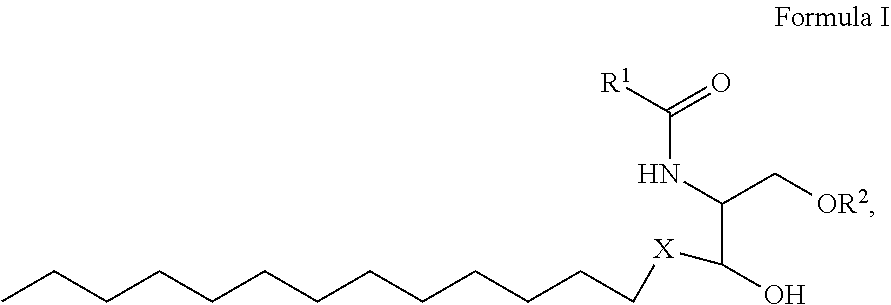

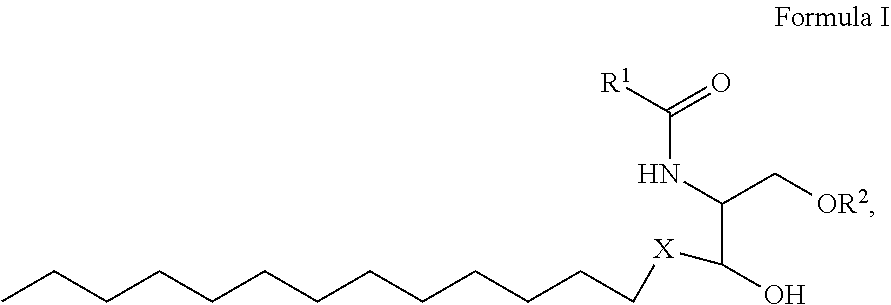

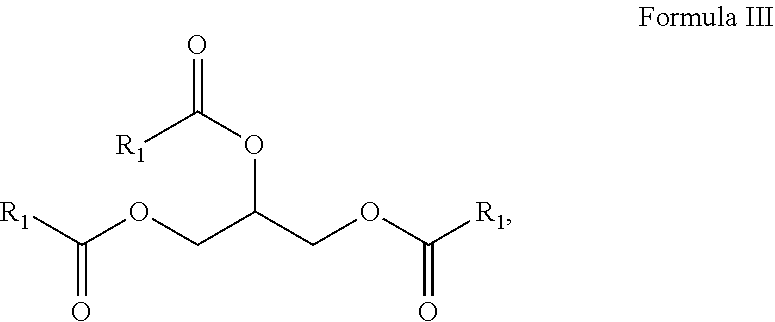
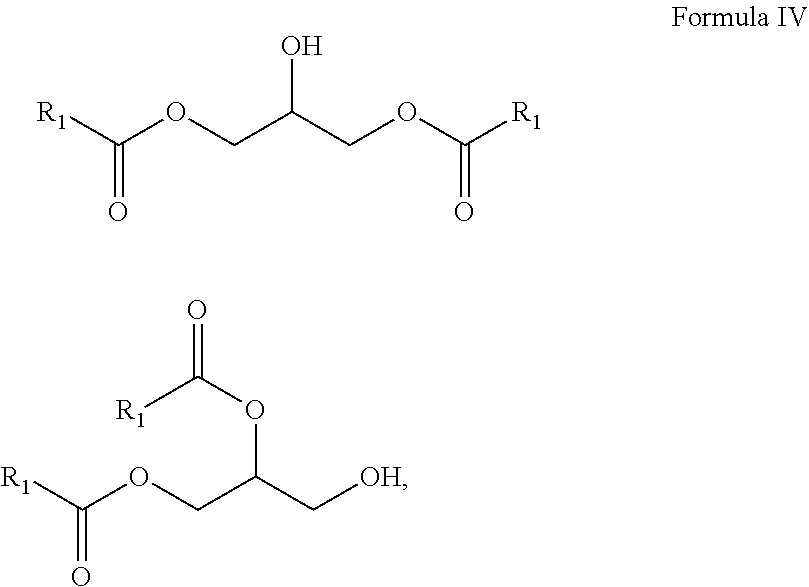
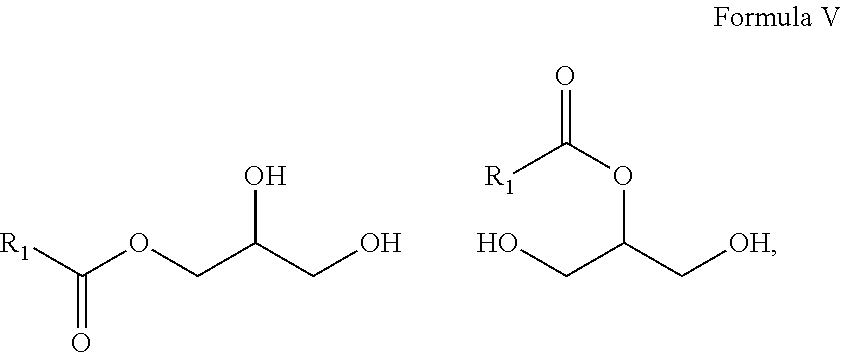
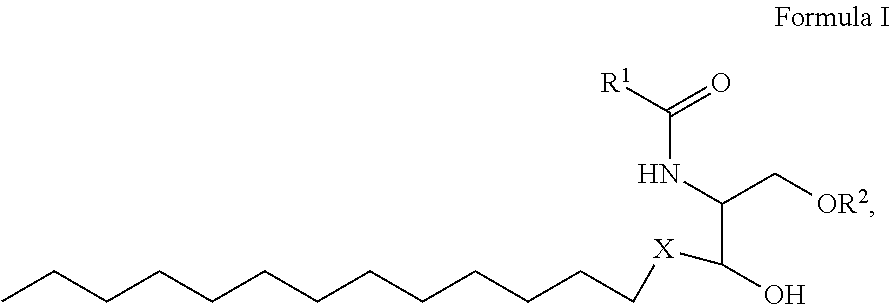

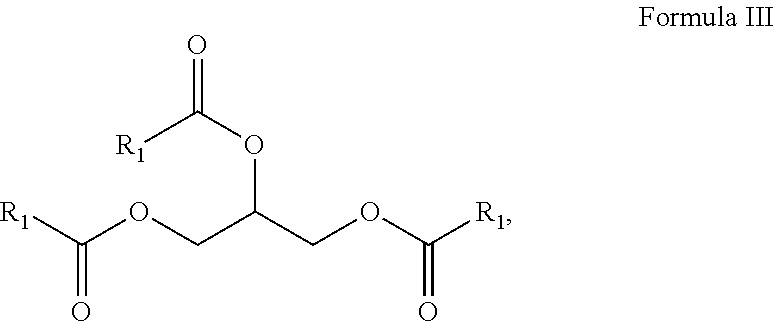
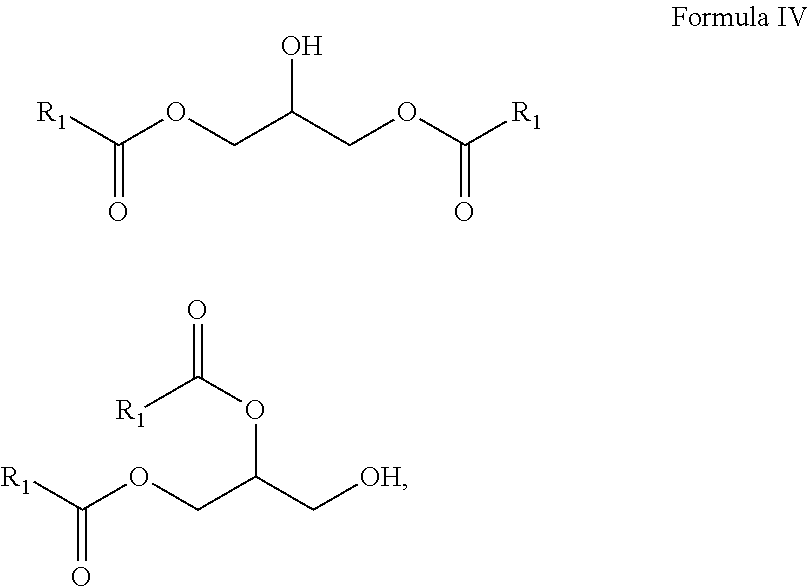
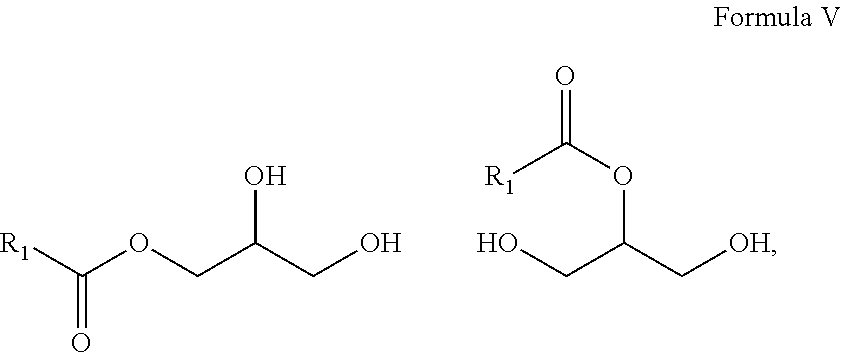
D00000
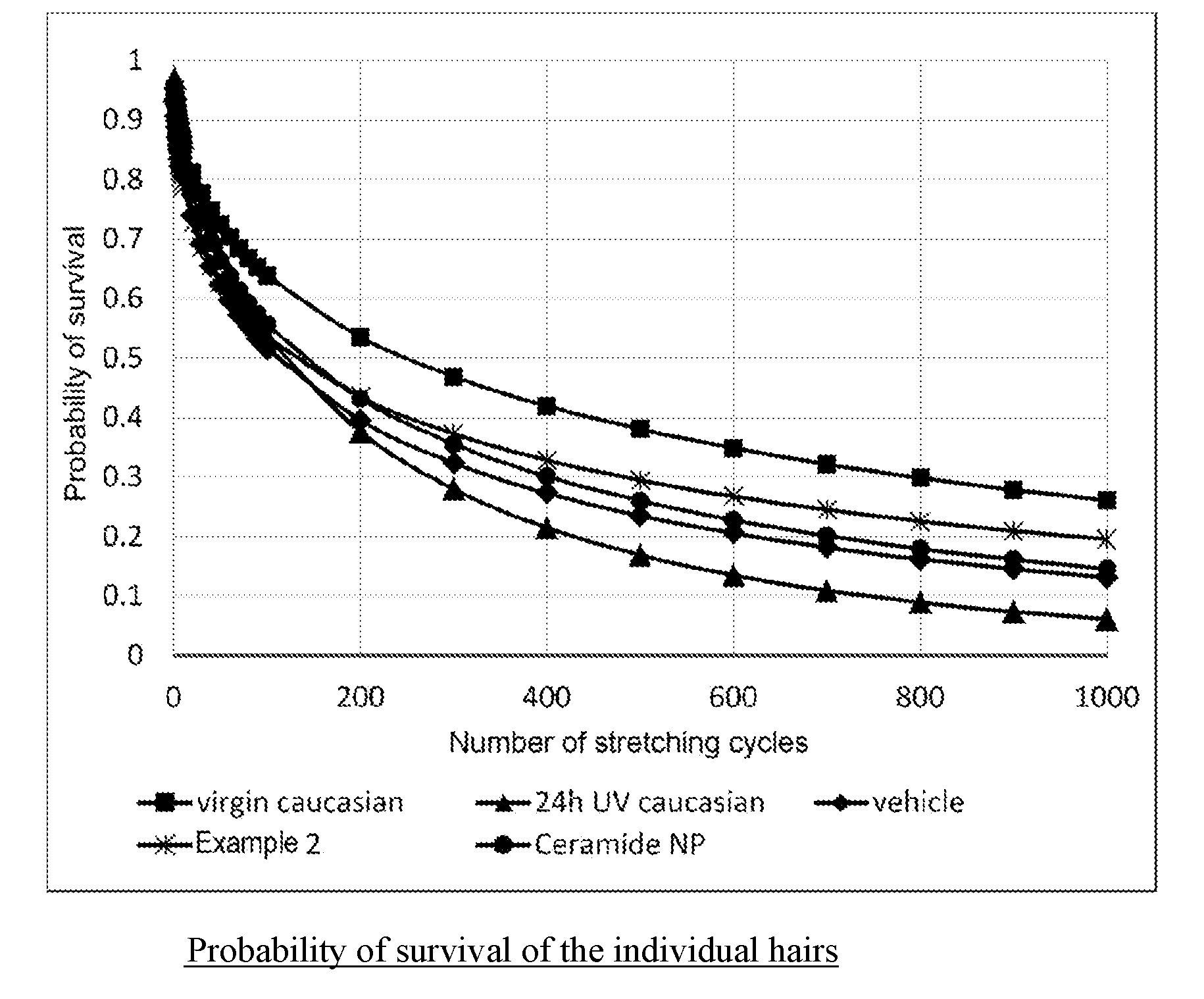
D00001
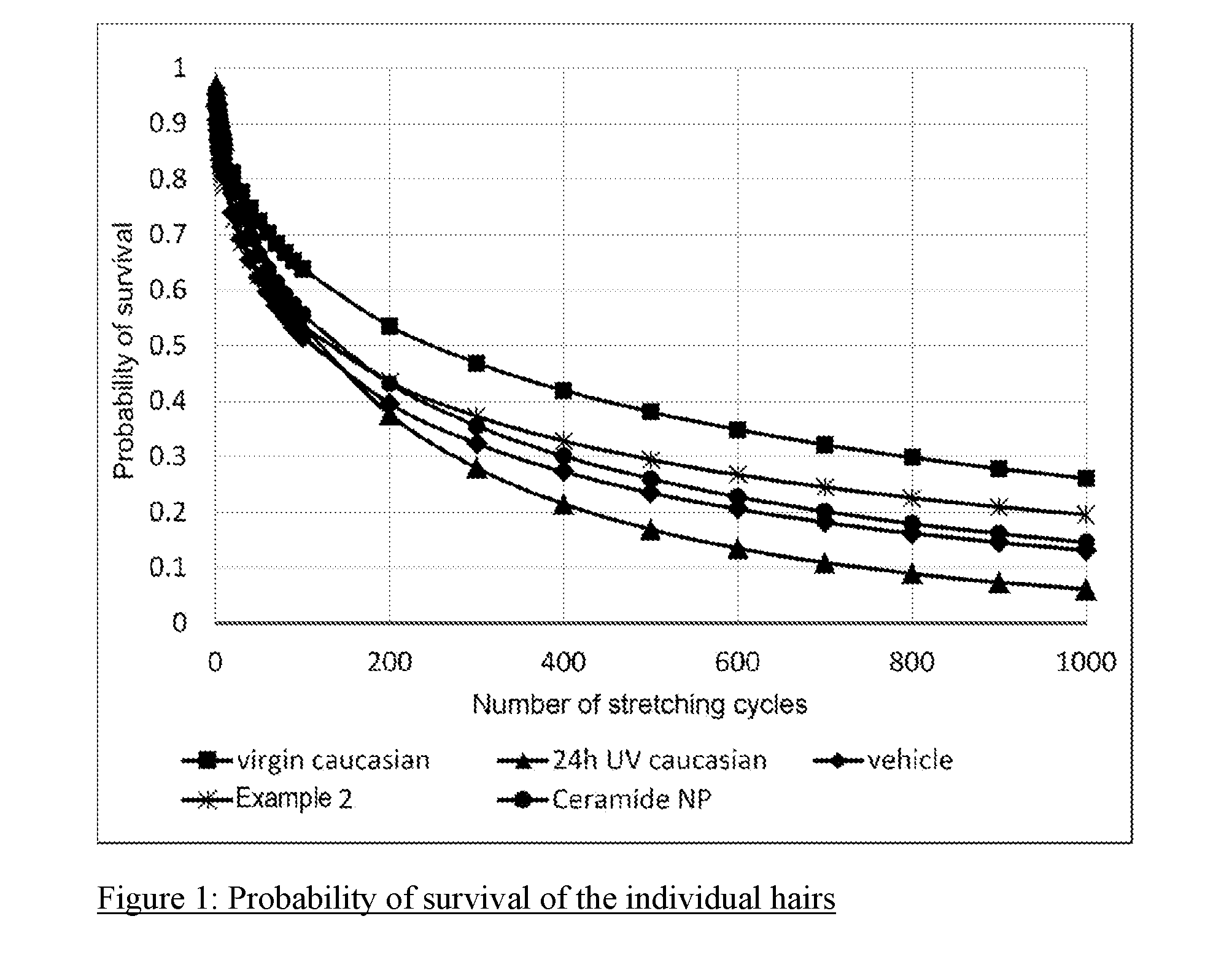
D00002
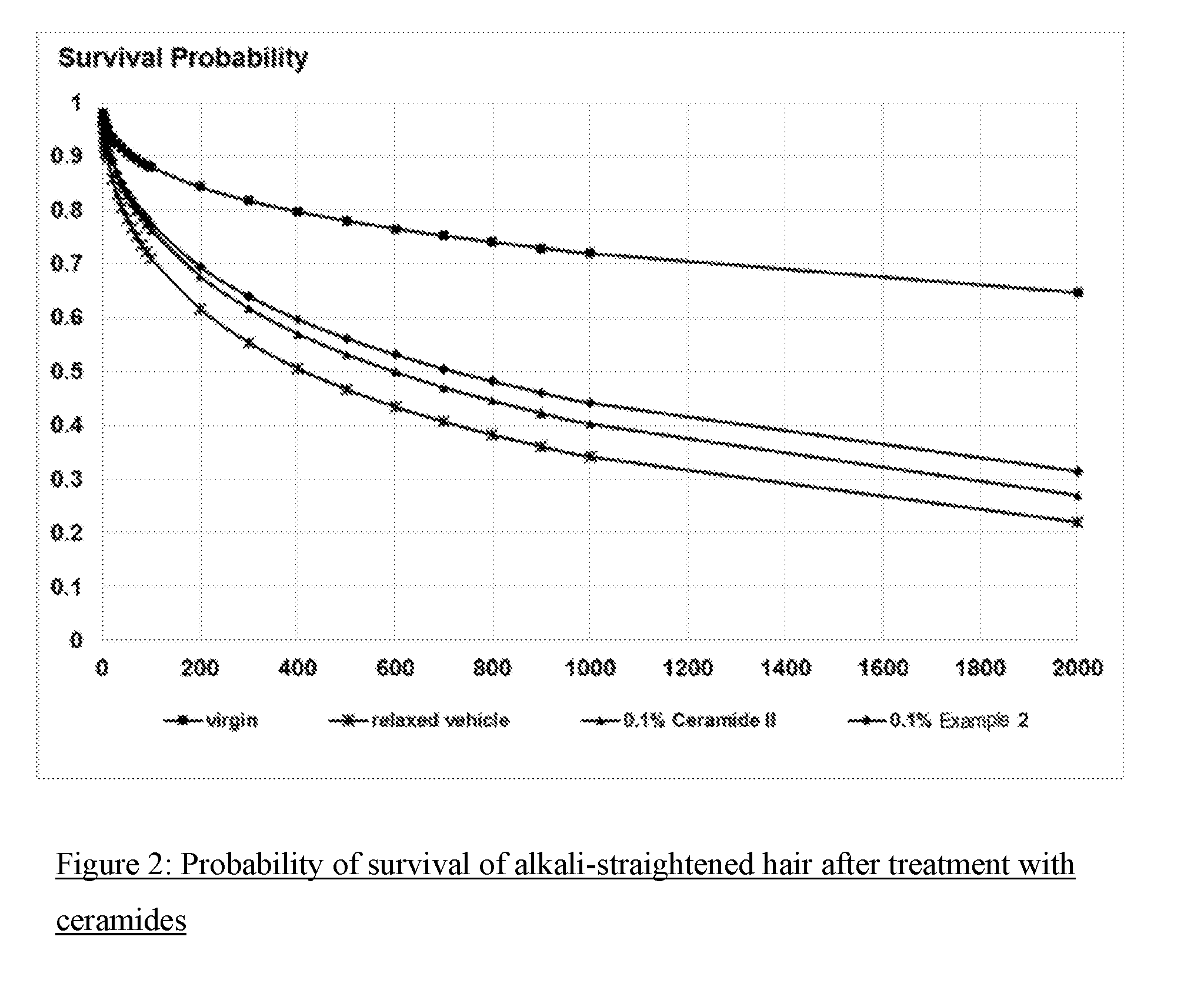
D00003
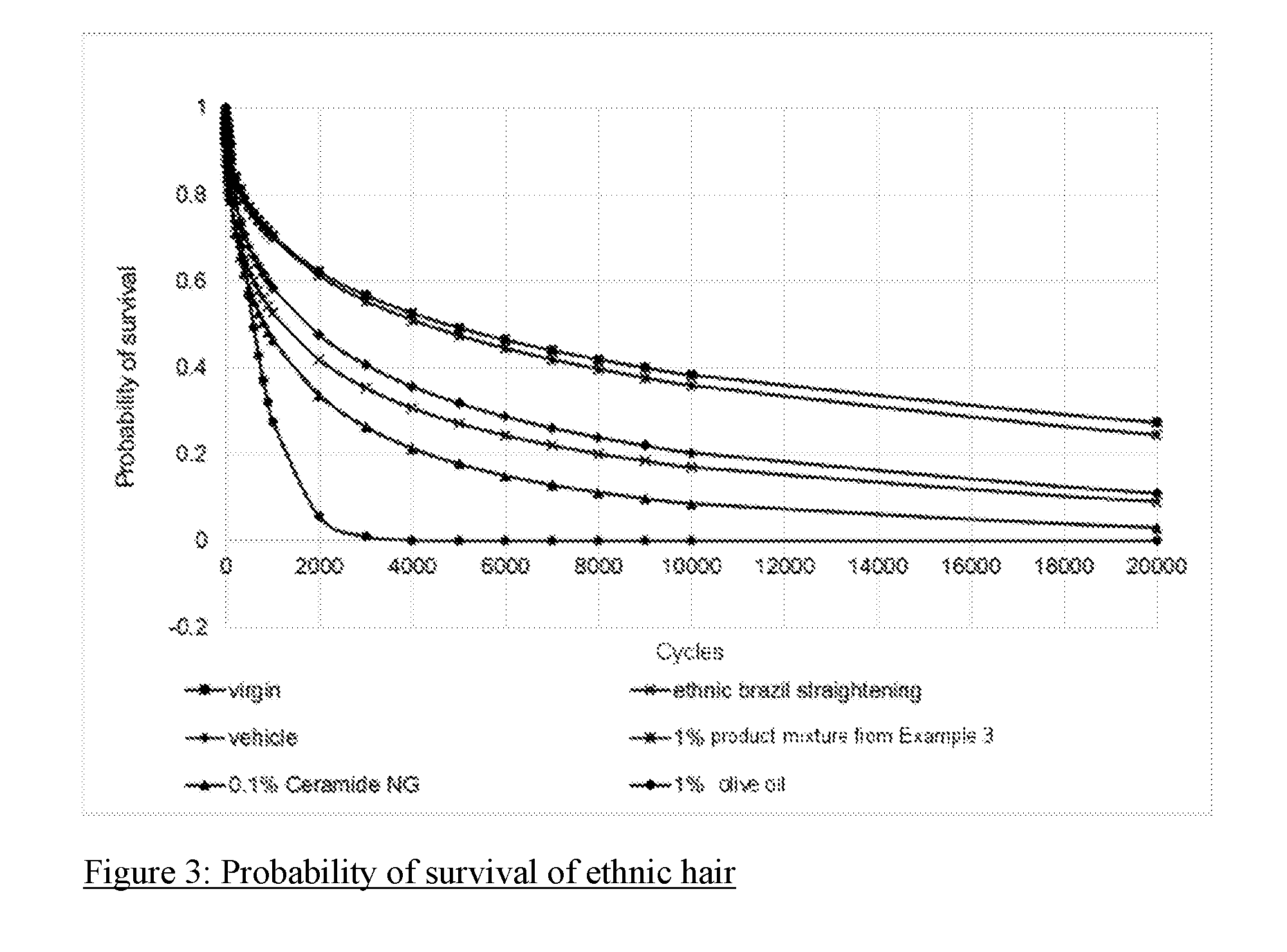
XML
uspto.report is an independent third-party trademark research tool that is not affiliated, endorsed, or sponsored by the United States Patent and Trademark Office (USPTO) or any other governmental organization. The information provided by uspto.report is based on publicly available data at the time of writing and is intended for informational purposes only.
While we strive to provide accurate and up-to-date information, we do not guarantee the accuracy, completeness, reliability, or suitability of the information displayed on this site. The use of this site is at your own risk. Any reliance you place on such information is therefore strictly at your own risk.
All official trademark data, including owner information, should be verified by visiting the official USPTO website at www.uspto.gov. This site is not intended to replace professional legal advice and should not be used as a substitute for consulting with a legal professional who is knowledgeable about trademark law.